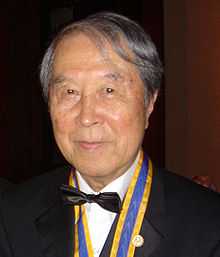Yoichiro Nambu
| Yoichiro Nambu 南部 陽一郎 | |
|---|---|
 | |
| Born |
January 18, 1921 Tokyo, Japan |
| Nationality | United States |
| Fields | Physics |
| Institutions |
University of Tokyo (1942-49) Osaka City University (1949-52) Institute for Advanced Study (1952-54) University of Chicago (1954-) |
| Alma mater | Tokyo Imperial University |
| Known for | Spontaneous symmetry breaking |
| Notable awards |
Heineman Prize (1970) US National Medal of Science (1982) Dirac Medal (1986) J.J. Sakurai Prize (1994) Wolf Prize in Physics (1994/1995) Pomeranchuk Prize (2007) Nobel Prize in Physics (2008) |
Yoichiro Nambu (南部 陽一郎 Nambu Yōichirō, born January 18, 1921) is a Japanese-born American physicist, currently a professor at the University of Chicago.[1] Known for his contributions to the field of theoretical physics, he was awarded a one-half share of the Nobel Prize in Physics in 2008 for the discovery in 1960 of the mechanism of spontaneous broken symmetry in subatomic physics, related at first to the strong interaction's chiral symmetry and later to the electroweak interaction and Higgs mechanism.[2] The other half share was split equally between Makoto Kobayashi and Toshihide Maskawa "for the discovery of the origin of the broken symmetry which predicts the existence of at least three families of quarks in nature."[3]
Early years
Nambu was born in Tokyo, Japan, in 1921. After graduating from the then Fukui Secondary High School in Fukui City, he enrolled in the Tokyo Imperial University and studied physics. He received his B.S. in 1942 and D.Sc. in 1952.[4] In 1949 he was appointed to associate professor at the Osaka City University and promoted to professorship the next year at the age of 29.
In 1952, he was invited by the Institute for Advanced Study in Princeton, New Jersey, United States, to study. He moved to the University of Chicago in 1954 and was promoted to professor in 1958.[5] From 1974 to 1977 he was also Chairman of the Department of Physics. He became a naturalized U.S. citizen in 1970.[6]
Career in physics
Nambu proposed the "color charge" of quantum chromodynamics, having done early work on spontaneous symmetry breaking in particle physics and having discovered that the dual resonance model could be explained as a quantum mechanical theory of strings. He is accounted as one of the founders of string theory.
After more than 50 years as a professor, he is now Henry Pratt Judson Distinguished Service Professor Emeritus at the University of Chicago's Department of Physics and Enrico Fermi Institute.
The Nambu-Goto action in string theory is named after Nambu and Tetsuo Goto. Also, massless bosons arising in field theories with spontaneous symmetry breaking are sometimes referred to as Nambu–Goldstone bosons.[7][8]
Honors and awards
Nambu has won numerous honors and awards including the Dannie Heineman Prize (1970), the J. Robert Oppenheimer Memorial Prize (1977),[9][10] Japan's Order of Culture (1978), the U.S.'s National Medal of Science (1982), the Max Planck Medal (1985), the Dirac Prize (1986), the Sakurai Prize (1994), the Wolf Prize in Physics (1994/1995), and the Franklin Institute's Benjamin Franklin Medal (2005). He was awarded one-half of the 2008 Nobel Prize in Physics "for the discovery of the mechanism of spontaneous broken symmetry in subatomic physics".[2][11][12]
References
- ↑ Mukerjee, M. (1995) Profile: Yoichiro Nambu – Strings and Gluons, The Seer Saw Them All, Scientific American 272(2), 37-39.
- ↑ 2.0 2.1 Nambu, Yoichiro (2008). Karl Grandin, ed. Les Prix Nobel. The Nobel Prizes 2008. Stockholm: The Nobel Foundation. Retrieved 22 May 2012.
- ↑ (according to the NP citation).
- ↑ 2005 Franklin Medal in Physics citation
- ↑ Chicago Tribune (October 8, 2008) "University of Chicago physicist Yoichiro Nambu wins Nobel Prize"
- ↑ Matt Moore, Karl Ritter, with Mari Yamaguchi and Herbert G. McCann (2008-10-07). "Chicago Professor Shares Nobel Prize In Physics". National Public Radio. Associated Press.
- ↑ Y. Nambu and G. Jona-Lasinio, Phys. Rev. 122, 345-358 (1961) doi:10.1103/PhysRev.122.345
- ↑ Y. Nambu and G. Jona-Lasinio, Phys. Rev. 124, 246-254 (1961) doi: 10.1103/PhysRev.124.246
- ↑ Walter, Claire (1982). Winners, the blue ribbon encyclopedia of awards. Facts on File Inc. p. 438. ISBN 9780871963864.
- ↑ "J. Robert Oppenheimer Prize awarded to Yoichiro Nambu". Physics Today (American Institute of Physics). March 1976. doi:10.1063/1.3023388. Retrieved 1 March 2015.
- ↑ Jonathan Amos (2008-10-07). "Cosmic imperfections celebrated". BBC.
- ↑ Pollard, Niklas (October 7, 2008). "Two Japanese, American win 2008 physics Nobel". Reuters.
External links
- Yoichiro Nambu, Department of Physics faculty profile, University of Chicago
- Profile, Scientific American Magazine
- Yoichiro Nambu, Sc.D. Biographical Information
- Nambu's most-cited scientific papers
- Yoichiro Nambu's earliest book for the scientific layman
- Yoichiro Nambu's previously unpublished material, including an original article on spontaneously broken symmetry
- Interview at the AIP Oral History Transcript site (July 16, 2004)
- "A History of Nobel Physicists from Wartime Japan" Article published in the December 1998 issue of Scientific American, co-authored by Laurie Brown and Yoichiro Nambu
| ||||||||||||||||||||||||||||||
| ||||||||||||||||||||||||
|
